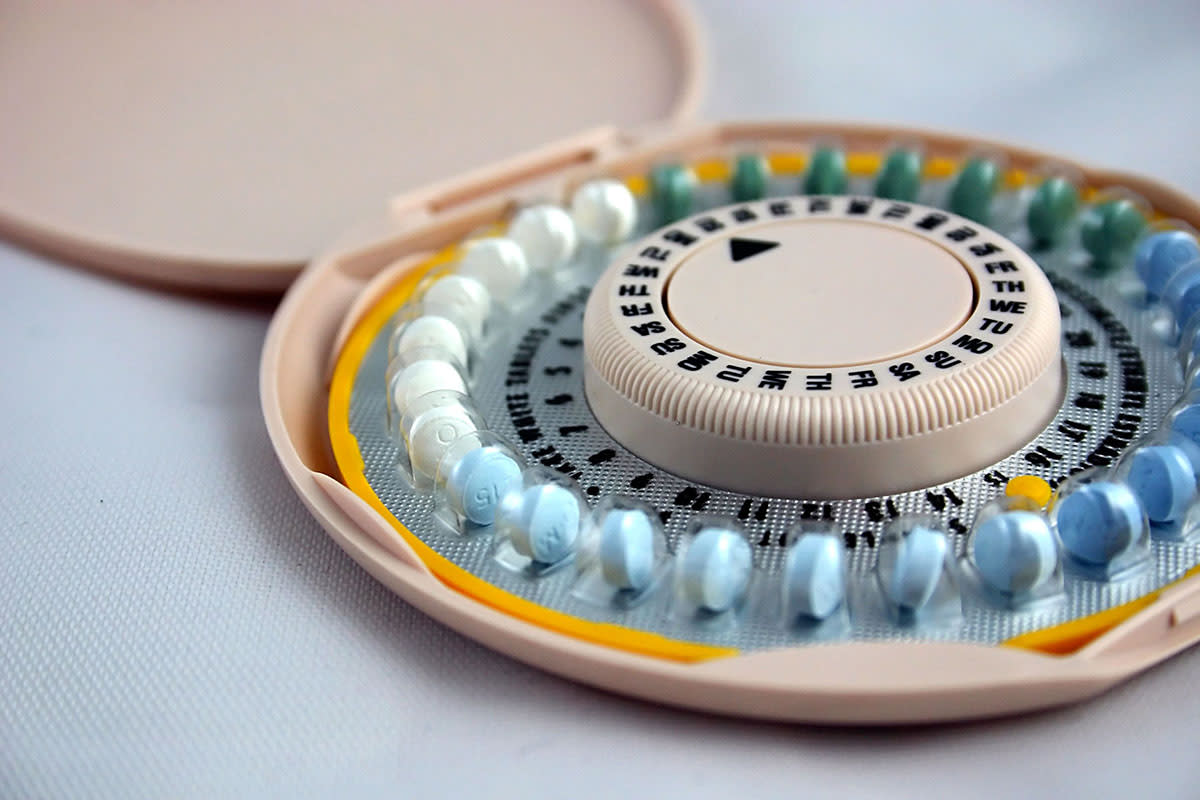‘The pain was so bad, I went to the ER a few times’: How birth control can work beyond pregnancy prevention

For many women, hormonal birth control is a way to help prevent an unintended pregnancy. But for some, it’s an important tool to help treat a serious health condition.
Austi Whetten, 29, is one of them. She has von Willebrand disease, a lifelong bleeding disorder that prevents her blood from clotting well. The condition affects both men and women, but because women have periods, they tend to be more symptomatic than men, she tells Yahoo Lifestyle.
“Every girl has stories of bleeding on her pants,” Whetten shares. “I just have a lot more than most people.”
She continues, “My first day of eighth grade at a new school, I couldn’t change my tampon often enough to prevent getting blood on the skirt I’d picked out for the occasion. I got blood all over a friend’s blanket I’d fallen asleep on at a slumber party. On a camping trip, I woke up having unexpectedly started my period overnight. I changed my clothes to walk to the bathroom. By the time I got to the bathroom, I’d bled through my pants again. Two hours later, we stopped at a rest area, and I’d bled through a third time.”
Whetten says she’s “tried it all, including wearing both a tampon and a pad, wearing two tampons at the same time, and keeping extra underwear in my backpack. I was never, ever without supplies.”
She adds, “Basically, when I was on my period, everything was more stressful: hanging out with friends, dance competitions, vacations, tests at school, going to work.” But it wasn’t just heavy bleeding that she had to deal with. “The other part of bad, long, heavy periods are the cramps,” she shares. “Missing school, missing work, missing extracurriculars … all because my cramps were so bad I could barely stand.”

Whetten began seeing a gynecologist for her periods when she was 16 and was quickly diagnosed with endometriosis, a painful disorder in which tissue that normally grows inside the uterus grows outside of it, “which is really common in women with von Willebrand disease,” she says. However, her doctor suspected that her heavy bleeding was due to something more and ran blood tests for von Willebrand disease — those came back positive.
“After I was diagnosed with von Willebrand disease, my hematologist said that being on the pill was the best way to help manage the bleeding symptoms on my menstrual cycle,” Whetten says. “It helped with my periods a bit, but if I took the pill a couple hours late, I would start spotting. So, I sometimes felt like I was always spotting, because I was young, and taking a pill every day at exactly the same time isn’t easy.”
However, Whetten says, the best thing about being on the pill was that she could skip her period entirely. “I felt like I was able to take back some control over my life,” she says. “I knew when my period was going to fall, because the pill gave me a real schedule. If it was going to happen during choir tour, I’d just skip [my period]. If it was going to fall during the week of my AP tests, I would just keep taking the hormone pills and take the placebos when it was more convenient for me. I remember it feeling like a superpower that I was able to control my period instead of it controlling me.”
‘This discovery changed my life’
Whetten had been through several brands of birth control pills to try to find the best fit for her. “The first kind didn’t really help control the bleeding. Other brands gave me migraines,” she says. “Then came all the emotional side effects. After a while of trying to play the side effects game, I gave up and stopped playing, and stopped taking the pill.”
For the next year or so, Whetten says, “it was like being a young teen all over again: cramps, blood, uncertain schedules.” Then, she decided to try a hormonal IUD. “This discovery changed my life,” she says. “My periods are regular, my cramps are manageable. I don’t have the hormonal side effects, and my flow is so light. I still have a regular period, but it is completely manageable. Sometimes I joke that having an IUD makes me into a normal woman.”
‘The pain was so bad, I went to the ER a few times’
At 24 years old, Kristy Curry was diagnosed with endometriosis. Before she went on birth control, “I had super-long, painful periods, back pain, nausea, and a lot of hip and leg pain,” the now-40-year-old tells Yahoo Lifestyle.
Sometimes the pain during her period was so bad that she had to go to the emergency room. “I was just told that I have painful periods, to take some Advil, and see my doctor,” she recalls.

Curry visited her ob-gyn, who properly diagnosed her, performed laser ablation surgery (which uses light to destroy cells) to treat the endometriosis, and recommended that she go on hormonal birth control pills to help control her symptoms. Curry says she’s tried several types but is currently on a combined hormonal pill (estrogen and progesterone) that works for her.
While birth control hasn’t been a magical pill for her, Curry says it has helped keep her endometriosis under control after surgeries for her condition — and she’s had several. “I feel like it’s helped maintain my body after the surgeries,” she says. “It’s definitely slowed down the progression of my endometriosis in a sense of my symptoms and how I feel.”
Birth control is a common treatment for several conditions
Hormonal birth control doesn’t just treat endometriosis and von Willebrand disease — it can also help with other conditions, such as irregular cycles, heavy menstrual bleeding, painful cramps, acne, PMS, polycystic ovary syndrome, functional ovarian cysts, fibroids, and menstrual migraines, Jennifer E. Dietrich, MD, chief of pediatric and adolescent gynecology and professor in the department of obstetrics and gynecology at the Baylor College of Medicine, tells Yahoo Lifestyle.
Hormonal birth control “can be life-altering for many adolescents and adult women who face chronic gynecologic conditions,” she says.
Here’s how it works: The hormones in birth control inhibit the feedback loop that allows for follicle stimulating hormone, or FSH (a hormone that promotes the release of an egg during a woman’s cycle), and luteinizing hormone (which stimulates ovulation) to be released in a woman’s body, Dietrich explains. “When these are not released, the ovary is not stimulated to produce hormones like estrogen and progesterone,” she says. Because a controlled amount of hormone is delivered by hormonal birth control, a woman’s cycles “become more manageable and predictable over time.”
Certain forms of hormonal birth control can also keep a woman’s endometrial lining thin (what’s shed during a period) and help decrease the heavy bleeding and pain from her cycle as a result, Dietrich says.
Ultimately, birth control can make a big difference in a woman’s life. “I am a different person now because I have an IUD,” Whetten shares. “The quality of life I enjoy now is almost unrecognizable to my teenage self. I don’t have to think and worry and constantly be aware of when my period might fall and how that is going to impact my life and what plans I will need to change as a result. For me, birth control has always had less to do with sexual activity than the simple fact that my genes gave me both a uterus and a bleeding disorder.”
Read more from Yahoo Lifestyle:
Follow us on Instagram, Facebook, and Twitter for nonstop inspiration delivered fresh to your feed, every day.

